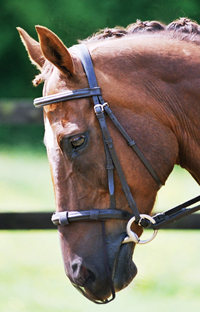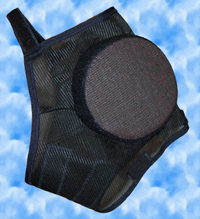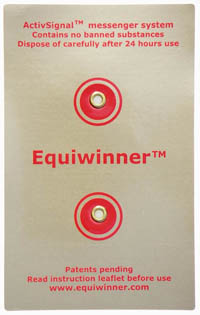It’s a gorgeous spring day, and you’re looking forward to a good ride. But minutes after your horse picks up a trot, he starts flipping his nose up and down. Is he lame? His stride seems even, and his head action isn’t a typical lame-horse head-bob–it’s a quick, snatching motion. Is his bit bothering him? You toss him the reins, but the up-and-down snatching continues. Is he just being a pill? You urge him forward to put his mind on work, but the motion only gets worse as he exercises harder. Soon he’s snorting and flipping his head so violently that you have to stop and get off.

Headshaking syndrome, in which the horse shakes or jerks his head uncontrollably for no apparent reason, has puzzled horsemen and veterinarians for at least a hundred years. It’s been blamed on everything from allergies to bad riding. There are still more questions than answers about this strange syndrome, but researchers are making progress in understanding and treating it.
Treating headshaking can be a long, frustrating process. Owners typically go through many different treatments, from antihistamines and anti-inflammatory drugs to acupuncture and homeopathic remedies, with little or no success. No treatment helps every horse, but these approaches have worked for some:
Masks
If light is a trigger, try having the horse wear an eye-shading fly mask that blocks ultraviolet rays. One to try is the Guardian Mask.
Muzzle Nets
If a horse is bothered during exercise, try a nose net or similar device. The nets are made of nylon mesh and attach to the horse’s noseband. There are several styles; some fully cover the muzzle, and some just hang over the nostrils. One to try is the Equilibrium Net Relief Muzzle Net.
Other
Barbara Socha of Signal-Health LLC sent us the following link to a product made by her company called Equiwinner. Signal-Health’s website says, “Equiwinner is a signaling device using Smart Cell SignalT, which restores the normal metabolism of the horse by communication with the body cell signaling system. In other words, the horse’s body can sense the electrolytes in the patches and responds to them. There are no ingredients as such, since nothing passes into the body of the horse except the signals. There are no side effects.” It is administered via a skin patch. To read more about this product, visit Signal Health’s website.

Reader Jolene Fargo, who is currently in the process of diagnosing her horse’s headshaking, recommended a product called Capstar. According to the company’s Web site, “Capstar is a non-medical homeopathic alternative to drug therapies” for eliminating or significantly reducing headshaking in horses. Jolene says that her neighbor had success using the product. To read more about this product, visit Capstar’s website.
Jolene has also started her own headshaking website with links to information and resources for diagnosing and treating headshaking that she has found on the Internet. While her website is still under construction, it is worth checking out if you have a diagnosed case of or suspect headshaking syndrome in your horse.

Have a favorite product to help manage headshaking syndrome? Email us at Practical.Horseman@EquiNetwork.com, and we’ll add it to this list. To read more about headshaking, see “All Shook Up” in the April 2009 issue of Practical Horseman.










